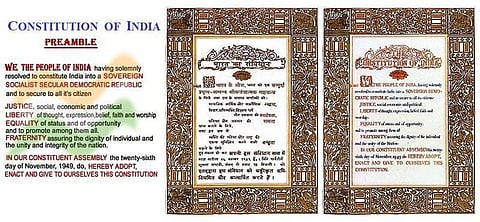
- Home
- न्यूजग्राम
- NewsGram USA
- India
- World
- Politics
- Entertainment
- Culture
- Lifestyle
- Economy
- Sports
- Sp. Coverage
- Misc.
- NewsGram Exclusive
- Jobs / Internships

BY NEHA HEGDE
The Indian Constitution can be viewed in two particular ways. The Conservative Constitution and the Transformative Constitution. One sounds more of criticism and the other to be appealing towards Constitutional measures. They both make sense in their own way.
Conservative Constitution:
Basically, this says that nothing progressive happened with the Constitution of India. The power which was in the hands of the British was just transformed into the hands of Indians. There is still indifference in New India even though the constitution was created to overcome it. It focuses on the nation rather than the individuality of every citizen. Gautam Bhatia in his book- 'The Transformative Constitution' mentions that this can be viewed as extending the country's power through colonization for various factors, just like the British did. The book also explains the dissent between Justice Shah and Justice Bose. Both consider the baseline for their argument as understanding history and constitutional theory.
Follow NewsGram on Instagram to keep yourself updated.
Justice Shah finds that the Indian Constitution just had a change in form and was given a new shape. But deep down, the application and execution of actions remain the same. His perspective towards the constitution was that it is conservatism and continuity. According to Justice Bose, the historical theories were wiped out by the creation of the constitution. A new order was brought which makes it transformative, which had a vision of progression.
It's ironic to say that constitution is transformative in nature because the Constituent Assembly had borrowed from the Government of India Act, 1935. 75% of our Constitution is based on the colonial laws which we had already gone through during the invasion of the British. Factually, it is the Westminster system of parliamentary democracy modeled by the United Kingdom. Indians were not independent in the past, even today Independence is just in the papers. The constitution can be defined as a polished framework of the governing body.
75% of our Indian Constitution is based on the colonial laws. Pixabay
Transformative Constitution:
It proves that the Indian Constitution has evolved into a radical body, with objectives of betterment and welfare. The term democracy has brought into action, we have Universal Adult Franchise. The aspects like political, social, and economic equality, liberty, justice make a huge difference in this era when compared to the past. There were social hierarchies, differentiation with respect to sex, religion, creed, etc. The fact that the constitution itself was formed to get rid of these makes it transformative. Constitution visions for a transformation in the nation, this fact again makes our constitution transformative.
Also Read: UN Agencies Urge People to Reduce Food Loss
It is still striving for a legal relationship between the individual and the state. We were not even in a Republic in the past, now we are here and it's all because of the constitution. For example- The Sati system wasn't even considered as a major thing back then, now we have law and order, a courtroom that decides to punish this heinous act. There are many numbers of examples to prove this. In curtness, this point of view says that our Constitution is in the direction of egalitarianism and progressive transformation.
